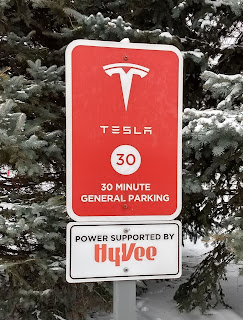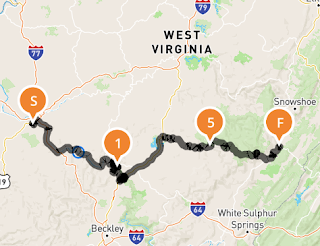EV Road Trips - Placement of Public Chargers
EV Road Trips - Placement of Public Chargers
 |
| MO 127 at I-70 - Image Source: Google Street View |
 |
| I-70 Community Hospital chargers, Sweet Springs, MO |
This charging stop turned out to be much less pleasant than the one earlier in the day, where I had spent a leisurely hour having breakfast, sipping coffee, and surfing the Internet at a McDonald's in Lexington, Missouri. At the Lexington location, I was occupied with my time spent on an Egg McMuffin, hash browns and coffee listening to the locals talk politics. I also connected to the free WiFi on my laptop checking news, social media, and updating the trip data for the future blog essay.
Back to the hospital location, I was grateful Kansas City Power & Light's Clean Charge Network extended beyond Kansas City city limits even if it only provided 7 KW as opposed to a 50 KW DC Quick Charging station. Nonetheless, it was relatively inconvenient to pair my charging with a meal, a cup of coffee, some shopping, or other activities while the car charged.
This experience vividly highlighted for me that charging locations for EVs, particularly those along travel corridors, need to be in a place where there are things to do for the driver. The decision makers who placed the early generation stations were likely well-intentioned, but had no clue about the realities of EV charging.
Why The Obsession with Road Trips?
I love to travel and particularly enjoy road trips. Given the new paradigm of electric vehicles and the fact that I recently sold my last internal combustion engine (ICE) car, I prefer to take these trips using EVs. The end of lease on my 2016 Nissan LEAF is approaching this year, so I'm starting the decision-making process of deciding whether to keep the 100-mile-range LEAF or upgrade to another EV that is more capable of road trips as a stable mate for my 2015 Tesla.
Wrong Tool For The Job
 |
| My LEAF charging in Atlanta, IL |
Road tripping in an electric vehicle other than a Tesla was discussed in the Electric Vehicle Road Trips blog essay from August 14, 2018.
The main points still hold true:
The main points still hold true:
- A bigger battery with more range is better.
- DC quick chargers along your route are essential to avoid long charge times.
Unfortunately I had neither available for this trip, which is precisely how less-than-ideal charging scenarios like the I-70 hospital and hanging out in a campground plugged into a 50A RV circuit came to be the only viable alternative (other than paying someone to move the car).
Read more about planning and executing this road trip in the August and September 2018 essays.
2019 - What Has Changed?
Affordable Long-Range EVs.
Fast forward to January 2019. A new generation of longer-range EVs is hitting the market in 2019. The Hyundai Kona, Kia Niro, and Nissan LEAF ePlus, all equipped with battery capacities around 60 kWh and 200+ mile range, join the Chevy Bolt EV as affordable long range EVs. These cars open up the possibility of electric vehicle road trips for the average driver not ready to part with $75,000 or more for a high-end Tesla Model S or X or even a mid-range $45,000 Model 3. I will mention Jaguar, Audi and Mercedes but while those models are out there or coming soon, they are hardly more affordable than Teslas.The Tesla Factor
 |
| Midwest Supercharger Network; Image source: Tesla |
Road Trip Charging Realities in Early 2019
 |
| Michigan PlugShare stations Image source: PlugShare |
My usual go-to app is PlugShare, which provides an overview of all stations as entered and rated by individual users. Level 2 stations (usually 7 KW, see also earlier essays for details on what the charging levels mean) can be found marked in green, home stations that people are willing to share are blue and DC Quick Chargers are marked in orange. Filter out the Tesla Superchargers and there isn't a lot of orange left.
 |
| Michigan EVGo network Image source: EVGO |
My LEAF relocation trip example shows that even an hour spent here and there on a Level 2 charger can give you enough range to bridge the gap to the next DC Quick Charger. In the case of the LEAF trip, the density of DC Quick Chargers in that part of the country was (and remains) so sparse that the next charger may well just be another Level 2 and a 3-hour charge. That situation just isn't acceptable for the majority travelers.
DC Quick Charging Networks
 |
| Electrify America stations mage source: EA |
 |
| Hy-Vee Tesla sign Image source: Karl Bloss |
Charger Placement
Tesla Superchargers
There's a reason why Tesla has a devoted fan base. Tesla has gone about their Supercharger placement in a manner consistent with the needs of their drivers. The locations make sense both in terms of placing the chargers along travel corridors such as interstate highways as well as near stores and restaurants where the drivers and their passengers can comfortably combine a charging stop with a meal, coffee, or light shopping.A good example of such well-planned Supercharger locations is the Midwest partnership with Hy-Vee grocery store chains. If you travel through Iowa along I-80 with your Tesla, those little red Supercharger icons on your car's navigation screen are nearly all at Hy-Vees.
The ability to do your weekly shopping or even just picking up a snack is not the reason these locations are so useful as a charging stop. Hy-Vee has outfitted most of their stores with a full-service Market Grille restaurant, premium coffee kiosks like Starbucks or Caribou, and counters where you can pick up prepared food including comfort food, pizza, sushi and even Mongolia BBQ. Couple this with 24-hour access to clean restrooms and free WiFi, it's easy to spend 30-40 comfortable minutes here while your car is gorging on electrons.
Tesla has a similar arrangement with Meijer stores in the upper Midwest which have very nearly services as Hy-Vee. Other locations are placed at or near shopping centers that allow the car's occupants to partake coffee, food, and other shopping. Contrast this to the I-70 hospital in the middle of nowhere.
EVGo
My encounters with EVGo DC Quick Charge locations have been mostly in the St. Louis and Chicago regions. In St. Louis, EVGo partnered with Commerce Bank locations which are typically in shopping centers. The Chicago area location I used was at a toll road "oasis" rest stop that also had restaurants and traveler services. Each had only one charging station, so I was reluctant to leave the car for long in case another power-needy car pulled in. While not quite as comfortable as the Hy-Vee or Meijer locations, these types of placements are also reasonably good in terms of traveler services. |
| Electrify America location Image source: PlugShare |
Electrify America
EA DC Quick Charge locations such as this Walmart location found on PlugShare (not open yet as of this writing) and others close to Casey's General Stores have also been researched and executed better than the first generation of chargers. One fundamental advantage over, say, the EVGo and ChargePoint locations I have used, is that each location has multiple chargers. This helps with the anticipated increasing demand as well as redundancy in case one charger has technical issues. Since EA was born out of VW funds and European manufacturers favor the CCS quick charging standard, there have been some complaints that EA stations have mostly CCS connectors and fewer CHAdeMO charging connector favored by manufacturers like Nissan and Mitsubishi.
Summary
Tesla Rules Road Trips
From a North American viewpoint, Tesla is still the king of EV road trip cars in the US. If you have the necessary funds, a Tesla will provide the easiest and most seamless road trip experience. It's worth noting that equipped with a CHAdeMO adapter, a Tesla Model S and X (but not the Model 3) can access any of the third-party DC Quick Charging networks. Of course all Level 2 stations are available to Teslas via the included adapter.
Long-Range EVs Are Capable Contenders
The next generation of 60+ kWh (and arguably 40 kWh) EVs, when coupled with the ever-growing DC Quick Charge infrastructure, can already take road trips. With some careful planning and depending on the location, such trips are already possible and in some cases, convenient.
Trip Planning
Planning tools such as the PlugShare Trip Planner (as discussed in an earlier essay) are still essential until the charging infrastructure catches up with gas stations and we can drive blissfully onto the open road assured that there's a charger somewhere out there. I also highly recommend backup charging locations and contingency planning such as extra time and possible impromptu hotel stays.
Still Not Sure?
If all of this stresses you out or delays have the potential to ruin a trip, then consider using your own or rented ICE car that meets your trip needs. The savings from regularly driving an EV will likely pay for the occasional rental for special transportation needs. After all, not everyone owns a 24' cube truck just in case you might have to move one day.If you travel extensively, perhaps a plug-in hybrid vehicle (PHEV) makes more sense until road trip charging become ubiquitous and easy.
Comments?
I would be interested in hearing about your EV road trip experiences and tips, particularly as it relates to charging solutions.
Resources:
- Charging Levels
- https://pluginamerica.org/understanding-electric-vehicle-charging/
- https://insideevs.com/charging-levels-explained-bower/
- Charging Networks
- PlugShare
- EV Driving Experiences
- Dave Laur in Olympia Washington
- YouTuber Ian Simpson in the UK.
- Follow me on Instagram: @muskegonevguy



Great info! It's interesting how road trip concerns change depending on mode of transportation. Thanks for your insight :) Alana
ReplyDeleteIt's one of the best blog I have came through, keep sharing such updates. double plug ev chargers
ReplyDelete